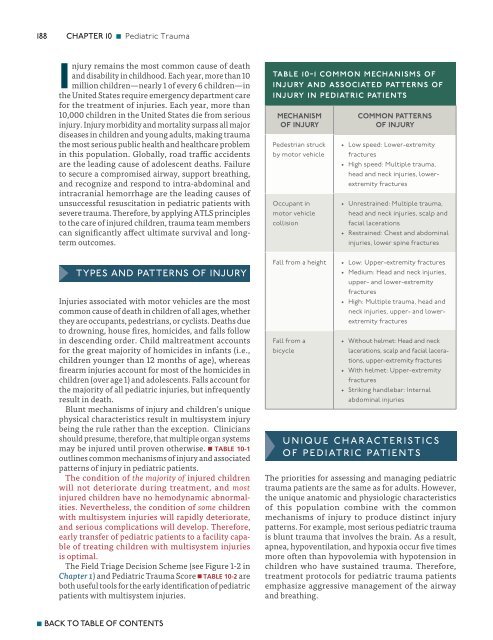Advanced Trauma Life Support ATLS Student Course Manual 2018
Create successful ePaper yourself
Turn your PDF publications into a flip-book with our unique Google optimized e-Paper software.
188<br />
CHAPTER 10 n Pediatric <strong>Trauma</strong><br />
Injury remains the most common cause of death<br />
and disability in childhood. Each year, more than 10<br />
million children—nearly 1 of every 6 children—in<br />
the United States require emergency department care<br />
for the treatment of injuries. Each year, more than<br />
10,000 children in the United States die from serious<br />
injury. Injury morbidity and mortality surpass all major<br />
diseases in children and young adults, making trauma<br />
the most serious public health and healthcare problem<br />
in this population. Globally, road traffic accidents<br />
are the leading cause of adolescent deaths. Failure<br />
to secure a compromised airway, support breathing,<br />
and recognize and respond to intra-abdominal and<br />
intracranial hemorrhage are the leading causes of<br />
unsuccessful resuscitation in pediatric patients with<br />
severe trauma. Therefore, by applying <strong>ATLS</strong> principles<br />
to the care of injured children, trauma team members<br />
can significantly affect ultimate survival and longterm<br />
outcomes.<br />
Types and PatteRNs of Injury<br />
Injuries associated with motor vehicles are the most<br />
common cause of death in children of all ages, whether<br />
they are occupants, pedestrians, or cyclists. Deaths due<br />
to drowning, house fires, homicides, and falls follow<br />
in descending order. Child maltreatment accounts<br />
for the great majority of homicides in infants (i.e.,<br />
children younger than 12 months of age), whereas<br />
firearm injuries account for most of the homicides in<br />
children (over age 1) and adolescents. Falls account for<br />
the majority of all pediatric injuries, but infrequently<br />
result in death.<br />
Blunt mechanisms of injury and children’s unique<br />
physical characteristics result in multisystem injury<br />
being the rule rather than the exception. Clinicians<br />
should presume, therefore, that multiple organ systems<br />
may be injured until proven otherwise. n TABLE 10-1<br />
outlines common mechanisms of injury and associated<br />
patterns of injury in pediatric patients.<br />
The condition of the majority of injured children<br />
will not deteriorate during treatment, and most<br />
injured children have no hemodynamic abnormalities.<br />
Nevertheless, the condition of some children<br />
with multisystem injuries will rapidly deteriorate,<br />
and serious complications will develop. Therefore,<br />
early transfer of pediatric patients to a facility capable<br />
of treating children with multisystem injuries<br />
is optimal.<br />
The Field Triage Decision Scheme (see Figure 1-2 in<br />
Chapter 1) and Pediatric <strong>Trauma</strong> Score n TABLE 10-2 are<br />
both useful tools for the early identification of pediatric<br />
patients with multisystem injuries.<br />
table 10-1 common mechanisms of<br />
injury and associated patterns of<br />
injury in pediatric patients<br />
MECHANISM<br />
OF INJURY<br />
Pedestrian struck<br />
by motor vehicle<br />
Occupant in<br />
motor vehicle<br />
collision<br />
Fall from a height<br />
Fall from a<br />
bicycle<br />
COMMON PATTERNS<br />
OF INJURY<br />
• Low speed: Lower-extremity<br />
fractures<br />
• High speed: Multiple trauma,<br />
head and neck injuries, lowerextremity<br />
fractures<br />
• Unrestrained: Multiple trauma,<br />
head and neck injuries, scalp and<br />
facial lacerations<br />
• Restrained: Chest and abdominal<br />
injuries, lower spine fractures<br />
• Low: Upper-extremity fractures<br />
• Medium: Head and neck injuries,<br />
upper- and lower-extremity<br />
fractures<br />
• High: Multiple trauma, head and<br />
neck injuries, upper- and lowerextremity<br />
fractures<br />
• Without helmet: Head and neck<br />
lacerations, scalp and facial lacerations,<br />
upper-extremity fractures<br />
• With helmet: Upper-extremity<br />
fractures<br />
• Striking handlebar: Internal<br />
abdominal injuries<br />
Unique ChARActeristics<br />
of Pediatric Patients<br />
The priorities for assessing and managing pediatric<br />
trauma patients are the same as for adults. However,<br />
the unique anatomic and physiologic characteristics<br />
of this population combine with the common<br />
mechanisms of injury to produce distinct injury<br />
patterns. For example, most serious pediatric trauma<br />
is blunt trauma that involves the brain. As a result,<br />
apnea, hypoventilation, and hypoxia occur five times<br />
more often than hypovolemia with hypotension in<br />
children who have sustained trauma. Therefore,<br />
treatment protocols for pediatric trauma patients<br />
emphasize aggressive management of the airway<br />
and breathing.<br />
n BACK TO TABLE OF CONTENTS

















